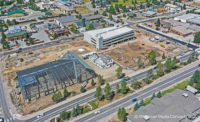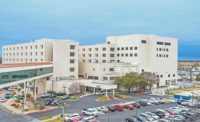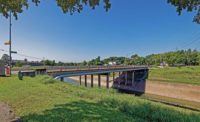Over the last 26 years, Oklahoma City has been on a mission to improve the quality of life for residents and make the capital even more of a place where people want to work and live.
The impetus for this initiative began in the early 1990s, when a major company had plans to move its operations to the city but then backtracked. The reason they gave Ron Norick, OKC mayor at the time: They couldn’t see making their people live in Oklahoma City, recalls David Todd, program manager of the Metropolitan Area Projects (MAPS) office for the city.
“That’s when Mayor Norick said we’ve got to invest in ourselves. We’ve got to build a city that people want to move to,” Todd says. “At the time, we had a downtown that nobody went to. At 5:30, it was empty.”

That led to the launch of MAPS. The first iteration of the capital improvement program was passed by voters in December 1993, funded by a 1-cent sales tax, which generated more than $309 million to build projects such as the Chickasaw Bricktown Ballpark, Bricktown Canal and Chesapeake Energy Arena.
“Having moved here in 1987 to attend Oklahoma State, we would visit the city occasionally. The primary destination was the Myriad, now Cox Convention Center,” recalls Kirk Mammen, vice president and area manager with Flintco LLC. “To witness the foresight and leadership of this state and Oklahoma City has been truly impressive, with their long-term vision and success of all the MAPS programs thus far coming to fruition.”
MAPS for Kids was the second program initiated back in 2001, raising $700 million in a campaign to improve schools in districts around the city.
“By building these new projects, putting the canal down here, building the new ballpark downtown, the new library—just bringing it back to life—caused some people to start moving downtown,” Todd says.
OKC is now working on MAPS 3, a $777-million campaign approved by voters in 2009 for construction of eight projects. Those include a $288-million convention center; the $132-million Scissortail Park; a $135-million modern streetcar system; a $57-million RIVERSPORT Rapids whitewater rafting and kayaking center on the Oklahoma River; $58.7 million in Oklahoma State Fairgrounds improvements; $55.5 million for four senior health and wellness centers; $39.5 million for walking, bicycling and running trails; and $18.1 million for improving sidewalks. The city manages all its projects under a design-bid-build delivery, per its charter.
“At the end of 2018, we were at the pinnacle of the program, and I think what really characterized the program for 2018 was the completion of the streetcar,” Todd says. “MAPS is a cash, pay-as-we-go program. So it takes a little while to ramp up, but once we’re ramped up, we get after it.”
Team Approach
On Dec. 14, the city celebrated the grand opening of its streetcar system. It was MAPS’s first foray into a major urban transportation project, says J.C. Brummond, senior vice president of Herzog Contracting Group, which built the system in a joint venture with Stacey & Witbeck.
The city was “very practical in their approach to things,” Brummond says.
Reconciling conditions in the field with the design proved to be one of the major challenges. When crews first came across site discrepancies, both the designers and the owner agreed to handle the problem as a team “rather than complaining or being resistant to contradicting their design documents. We got in front of it,” Brummond recalls. “We found a way to correct everything in advance and took care of it for pennies on the dollar for what it would have cost had they not been proactive.”
“MAPS is a cash, pay- as- we-go program. So it takes a little while to ramp up, but once we’re ramped up, we get after it.”
– David Todd, Program Manager, MAPS Office, Oklahoma City
The landmark piece of MAPS 3 is the convention center, where construction began in June, with completion expected in 2020. It’s also the single largest structure delivered under any of the MAPS programs to date, says Mammen. Flintco is contractor on the project.
While the original MAPS program remodeled parts of the convention center, the facility was about 50 years old and lacking some modern amenities, Todd says. “This new one is roughly twice as big as the existing one. It has about 200,000 sq ft of exhibit hall, 30,000 sq ft of ballrooms and 45,000 sq ft of meeting rooms,” he says.
The convention center is strategically positioned for prominent views of the park to the west and oriented for southern exposure throughout the year, Mammen says.
“Additionally, the design contains some impressive structural elements enhancing the overall aesthetics, including complex angles and cantilevers providing the desired architectural expression as well as a large main entry with open space requiring the proper sequencing of the structural, exterior and finish elements,” he says.
Adding to the complexity of the project, which is positioned on a two-square-block area, is its close proximity to two other projects currently under construction. It sits across the street from Scissortail Park, a 70-acre park being built in two sections, and next door to the $191-million, 600,000-sq-ft Omni Oklahoma City Hotel, which rises 17 stories above downtown.
“A project of this size and scope will present its share of issues to navigate—construction is not an exact science,” Mammen says.
The city provides oversight during all phases of the projects, notes Brandon S. Downey with Downey Contractors, which is building Scissortail Park. The firm completed the RIVERSPORT Rapids facility in 2016.
“Without their open communication and presence, they would not have been able to accomplish what they have,” Downey adds. “The city of Oklahoma City has a reputation for being a fair, honest owner.”
Into the Future
When the MAPS program first began, it offered a unique approach to project funding, Todd recalls. Today, Oklahoma City is still approached by other municipalities seeking to emulate parts of the program.
“What made it so unique is that there was no financing. It’s cash, so when we finish the convention center, it’s paid for,” Todd says. “And that’s what’s always been attractive to the voters in this city—there’s no long-term debt. The other thing is the way the program is set up is when the vote is taken. It says it will start here and end here. It’s for a defined duration.”
That level of transparency has helped the city generate voter support for capital improvements on a large scale. “I think often people are disappointed in government because they don’t get what they thought they were going to get or they didn’t meet budget or something, and that’s been really key to our program—delivering what we promised we were going to deliver,” Todd says.
While the city council oversees MAPS, it is assisted by a Citizens Advisory Board, created to review proposed projects and recommend actions to the city council. All advisory board members are residents.
Over nearly three decades, MAPS has spurred nearly $3 billion in private investment across Oklahoma City. “With MAPS 3, we’re getting tons of new residential properties downtown that probably wouldn’t have happened without this,” Todd says.
But MAPS is not the city’s only project generator. When sales tax collections for MAPS 3 officially ended on Dec. 31, 2017, after nearly seven years, a temporary penny sales tax took effect on Jan. 1, 2018, that runs through March 31, 2020. The tax aims to generate $240 million for street resurfacing, streetscapes, trails and sidewalks as part of the Better Streets, Safer City program.
Voters approved the program in September 2017 as a $967-million general obligation bond package that uses property tax revenue to fund projects such as libraries, parks, police and fire facilities, drainage control systems and others.
The city also has a massive water project on the horizon—its largest in over 50 years. Work on the second Atoka Pipeline, a $700-million, 100-mile, 72-in. pipeline is expected to start this summer and end in 2024.
There’s also the promise of another MAPS, dubbed MAPS 4. The city expects it to be put on the ballot in December. OKC officials are currently soliciting public input on projects for the new program.
In January, during the 2019 State of the City address, OKC Mayor David Holt noted that the city had already received more than a thousand ideas for projects, including an aquarium, city beautification, facilities to help with homelessness, a multipurpose stadium and a coliseum at the state fairgrounds.
“These are such monumental projects that we have a lot of healthy competition for architects and engineers to get the projects, and I think that a lot of our contractors make an extra effort to try and get one of these projects because everybody wants to be a part of the program,” Todd says.








Post a comment to this article
Report Abusive Comment